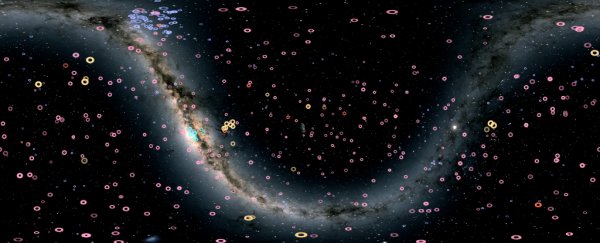Earth is not alone, and a stunning new animation created using NASA data beautifully illustrates that point.
There may be trillions of other planets in our galaxy, the Milky Way (which itself is one of hundreds of billions of other galaxies in the universe). But finding such extrasolar planets, or exoplanets, is not easy – even when they're relatively close by.
In fact, it takes more than four years for light to travel from the nearest star to our solar system. Meanwhile, exoplanets are both small and dim, and the Milky Way is a 100,000-light-year-wide haystack for astronomers to scour.
Despite their long odds, however, astronomers have logged thousands of exoplanets since a team confirmed the existence of the first one in October 1991. This June, in fact, marked a milestone: Researchers logged the 4,000th discovery in an ever-growing NASA archive of exoplanets.
To celebrate the achievement, two artists pulled all of that data and compiled it into a short animated map and timeline called "4000 Exoplanets," shown below.
The animation was created by the artist Matt Russo and scored by the musician Andrew Santaguida, who both work with a science-art outreach project called System Sound. The short film was published on YouTube on Sunday and described on Wednesday by NASA's Astronomy Picture of the Day (APOD) site.
What the animated exoplanet timeline shows
The video shows a flattened map of the 360-degree night sky as seen from Earth. The bright band of stars in the center is a cross-cut view of the Milky Way; it looks this way because our solar system drifts within the spiral galaxy.
Each circle that appears represents a confirmed exoplanet discovery. The main method used to find each world is shown as one of seven colours.
For example, purple circles show a planet found by its transit, or passage in front of a parent star; this is detectable because it causes periodic subtle drops in the parent star's brightness level relative to Earth. Pink, meanwhile, shows distant worlds that were located because their gravitational pull was strong enough to make their star "wiggle" sufficiently for astronomers to detect.
The pace of discoveries in the 60-second timeline starts off slowly, with only about 70 extrasolar worlds located in the first decade of discoveries. That's because finding and confirming the existence of exoplanets was extraordinarily difficult without advanced tools and resources.
But as funding grows, techniques improve, more ground telescopes help with the search, and new space observatories launch into space, the rate at which exoplanets have been found has increased. The pace of discovery really exploded after 2009, when NASA launched its Kepler Space Telescope.
Kepler focused its search on a small patch of the sky and used the transit method of exoplanet detection on 150,000 stars. This is why, in the animation, a big purple blob suddenly begins to appear around 2010 (at top left) and the exoplanet count skyrockets.
NASA deactivated Kepler in 2018, but in April 2018, NASA launched a similar planet hunter called the Transiting Exoplanet Survey Satellite (TESS).
TESS is expected to scan 200,000 nearby stars across 85 percent of the night sky, revealing thousands of additional planets. Below is an animation of TESS's planned survey.
Around 50 of the planets TESS detects should be Earth-sized and potentially habitable, creating promising targets for more detailed observations by telescopes that can image objects much deeper in space.
The first pictures of Earthlike worlds may come from enormous ground-based observatories, including the Giant Magellan Telescope in Chile, which are poised to come online starting in the mid-2020s.
Astronomers hope such telescopes can take raw exoplanet discoveries a step further by picking up light from their atmospheres – and potentially "sniffing" out biosignatures that may indicate the presence of alien life.
This article was originally published by Business Insider.
More from Business Insider:
